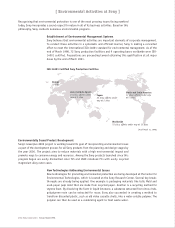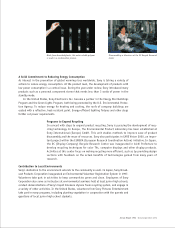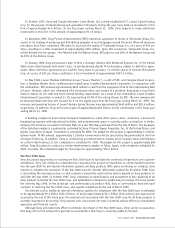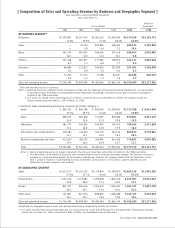Sony 1998 Annual Report Download - page 47
Download and view the complete annual report
Please find page 47 of the 1998 Sony annual report below. You can navigate through the pages in the report by either clicking on the pages listed below, or by using the keyword search tool below to find specific information within the annual report.
Annual Report 1998 Sony Corporation [45]
In October 1997, Sony and Toyoda Automatic Loom Works, Ltd. jointly established S.T. Liquid Crystal Display
Corp. for the purpose of manufacturing next-generation LCD panels. During the year, Sony made an investment in this
firm of approximately ¥4.0 billion. In the fiscal year ending March 31, 1999, Sony expects to make additional
investments in this firm in the amount of approximately ¥11.0 billion.
In November 1997, Sony Pictures Entertainment (SPE) reached an agreement to invest in Telemundo Group, Inc.
as part of its strategy of producing and distributing programs in local languages around the world. When all necessary
procedures have been completed, SPE plans to purchase the equity of Telemundo Group, Inc. at a price of $44 per
share, resulting in a total investment of approximately $125 million. Upon this acquisition, Telemundo Group, Inc.
will be divided into two groups – the Network and the Station Group. SPE plans to own 50% of the Network Group and
24.95% of the Station Group.
In January 1998, Sony announced a plan to form a strategic alliance with NextLevel Systems Inc. of the United
States (now called General Instrument Corp.), to jointly develop digital TV technologies, subject to definitive agree-
ments. When definitive agreements are reached, Sony plans to purchase 7.5 million shares of General Instrument
Corp. at a price of $25 per share, resulting in a total investment of approximately $187.5 million.
In May 1998, Loews Theatres Exhibition Group (“Loews Theatres”), a unit of SPE, and Cineplex Odeon Corpora-
tion, a Canadian theatre chain, combined and created Loews Cineplex Entertainment Corporation. In conjunction with
the combination, SPE received approximately $400 million in cash from the repayment of all of the intercompany debt
of Loews Theatres, which was refinanced with third party debt, and receipt of a dividend. Sony plans to use these
funds to reduce its U.S. debt and meet internal funding requirements. As a result of the combination, Loews Cineplex
Entertainment Corporation is owned 51.1% (representing 49.9% of the voting shares) by SPE. The new company will
be deconsolidated and Sony will account for it on the equity basis from the fiscal year ending March 31, 1999. The
revenues and operating income of Loews Theatres during the year were approximately $462 million and $20.6 million,
respectively. In addition, Sony will record a gain of approximately $36 million on the combination in the fiscal year
ending March 31, 1999.
A building complex to house Sony’s European headquarters, rental office space, stores, residences, a movie and
broadcasting museum with educational facilities, and entertainment space is currently under construction in Berlin,
Germany. The structure is located in Potsdam Platz on a site that Sony purchased from the City of Berlin. The developer
of the building complex is a partnership controlled by Sony, Tishman Speyer Properties, Inc. of the United States, and
Kajima Corporation of Japan. Completion is scheduled for 2000. The budget for this project is approximately 1.5 billion
German marks. Of this amount, approximately 1.0 billion German marks will be procured by the partnership in the form
of project financing. In addition, Sony is constructing an entertainment complex which includes stores and theatres
on a site in San Francisco, U.S.A. Completion is scheduled for 1999. The budget for this project is approximately $85
million. Sony also plans to construct a similar entertainment complex in Tokyo, Japan, with completion scheduled for
2000. Currently, the estimated budget for this project is approximately ¥12.0 billion.
The Year 2000 Issue
Sony has placed top priority on resolving the Year 2000 issue to facilitate the continuity of operations and customer
satisfaction. Sony has initiated a comprehensive corporate-wide project to implement an uninterrupted transition
into the year 2000 for all internal information systems and Sony products. With plans continuing on schedule, Sony
expects to complete the resolution of the Year 2000 issue for internal information systems by December 1998. Sony
is also taking the necessary actions so that customers around the world will be able to depend on Sony products on
and after the year 2000. In October 1997, Sony completed an identification and assessment of the capability of all
Sony products to handle the Year 2000 issue, and established a structure to enable Sony to manage this issue around
the world by May 1998. In the broadcast- and professional-use product field, Sony is continuing to deal with each
customer in resolving the Year 2000 issue, and expects completion by the end of March 1999.
The external cost to modify all internal information systems for compliance with the Year 2000 issue is estimated
to be approximately ¥9.2 billion ($70 million), of which approximately ¥2.1 billion ($16 million) was expensed as
incurred by the end of this fiscal year. The external cost associated with the Year 2000 issue for all Sony products is
currently expected to be minimal. Sony expects such costs would not have a material adverse effect on consolidated
operations and financial results.
Although Sony will make every effort to eliminate any impact of the Year 2000 issues, there can be no assurances
that Sony will in fact achieve this goal due to uncertainties that Sony is currently unable to forecast.
























